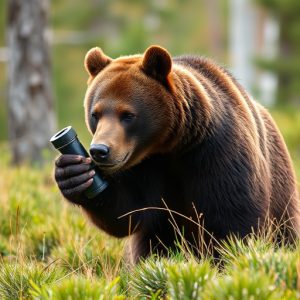Wilderness Safety: Mastering Grizzly Bear Defense with Bear Spray and Beyond
Encountering a grizzly bear? Maintain a safe distance (100+ yards) and understand defensive cues lik…….
Encountering a grizzly bear? Maintain a safe distance (100+ yards) and understand defensive cues like ears back & huffing. Use bear spray effectively within 50-70 feet, aiming at the face while retreating. Practice regularly to ensure proper use, as close or overshot sprays may fail. Combine strategies: distance, spray, noise makers, air horns, resistant clothing & secure food storage.
In the vast wilderness, encounters with grizzly bears can be life-altering. Understanding bear behavior and employing effective defense strategies is paramount for safety. This article guides you through a comprehensive approach to navigating these powerful creatures. We explore key aspects like recognizing bear spray’s necessity, proper application techniques, and maintaining crucial distances. Additionally, we delve into alternative strategies beyond bear spray, ensuring a well-rounded understanding of wilderness safety.
- Understanding Grizzly Bear Behavior: Key to Safety
- Evaluating the Situation: When and Where Bear Spray is Necessary
- Choosing and Applying Bear Spray Effectively
- Maintaining Proper Distance: A Crucial Defense Mechanism
- Alternative Strategies: Beyond Bear Spray for Wilderness Safety
Understanding Grizzly Bear Behavior: Key to Safety
Grizzly bears, known for their strength and ferocity, are powerful creatures that should never be underestimated. Understanding their behavior is a crucial step in ensuring your safety when encountering them in the wilderness. These majestic animals typically avoid humans, preferring to keep their distance. However, they may charge if they feel threatened or surprised, especially when protecting their cubs or food sources.
Knowing how to interpret their body language and maintain the proper distance is key. For instance, a grizzly bear may display defensive behavior with its ears back, whiskers twitching, and a huffing sound. If you spot these signs, quickly assess your surroundings, and consider using bear spray if within the recommended 75-foot (23 meter) range. The proper use of bear spray can deter a charging bear, giving you valuable time to escape or climb a nearby tree.
Evaluating the Situation: When and Where Bear Spray is Necessary
When encountering a grizzly bear, assessing the situation is crucial before considering any defense mechanism, especially when it comes to bear spray. The effectiveness of bear spray depends on several factors, and using it at the right moment can make all the difference. Bear spray is most necessary when you are within the proper distance of a bear, typically close enough for the bear to detect your presence but still far enough away to allow for effective application and reaction time. This usually means staying at a safe distance of 100 yards or more from bears in areas known for their presence.
The scenario where bear spray becomes indispensable is when a bear exhibits defensive or aggressive behavior, such as charging, growling, or swatting at the ground near you. In these cases, quickly deploying bear spray can deter the bear by creating a barrier of irritants that disrupt its senses, allowing you to safely move away and escape potential danger. Remember, the key is to use it appropriately, staying calm and ensuring the bear’s attention remains focused on the spray rather than you, providing an opportunity to retreat to safety.
Choosing and Applying Bear Spray Effectively
When faced with a grizzly bear charge, knowing how and when to deploy bear spray can be a life-saving skill. The first step is understanding the proper distance for its use. Bear spray should be used as a last resort from a safe distance, typically around 20 to 30 feet (6 to 9 meters). At this range, you can effectively create a barrier between you and the bear without risking close encounter or further provocation.
To apply the spray, aim for the bear’s face and eyes, creating a thick cloud that will disrupt its sense of smell and vision. Keep moving as you spray to ensure you maintain the safe distance and don’t get caught in a concentrated blast. Remember, it’s crucial to practice with bear spray regularly to become familiar with its range and effectiveness, ensuring your safety in the event of an actual encounter.
Maintaining Proper Distance: A Crucial Defense Mechanism
When encountering a grizzly bear in the wilderness, maintaining proper distance is a vital defense mechanism. It’s crucial to remember that bears have a vast sense of space and often prefer to avoid human contact altogether. By staying at a safe distance, typically 100 yards or more, you give the bear ample room to retreat and reduce the risk of an aggressive encounter. This distance allows for observation, giving you valuable time to assess the bear’s behavior before taking further precautions.
Proper distance management is especially key when considering the effective use of bear spray. While this can be a powerful deterrent, it should complement, not replace, maintaining physical separation. When using bear spray, ensure you follow instructions regarding range and wind conditions for optimal effectiveness. The goal is to create a barrier that gives you time to escape or deter the bear without causing harm, making proper distance an indispensable part of your defense strategy.
Alternative Strategies: Beyond Bear Spray for Wilderness Safety
In addition to carrying bear spray, maintaining a safe distance from bears is paramount. While many rely on bear spray as their primary defense, it’s crucial to understand its proper use and limitations. The recommended distance for effective bear spray application varies depending on the bear’s behavior and proximity. Generally, this range falls between 50 to 70 feet (15 to 21 meters). Spraying from a closer distance may not give enough time for the bear to retreat, while overshooting can be counterproductive, as it might agitate the animal further.
Alternative strategies for wilderness safety include making noise to deter bears, carrying and using air horns, or wearing bear-resistant clothing and gear. Additionally, being aware of your surroundings, avoiding known bear habitats during peak seasons, and securing food properly can significantly reduce conflict risks. These combined approaches offer a more comprehensive approach to wilderness defense against charging grizzly bears.
In conclusion, effectively defending against charging grizzly bears in the wilderness requires a multifaceted approach. While bear spray is a crucial tool, understanding grizzly behavior, evaluating the situation, choosing and applying the spray properly, and maintaining the proper distance are essential components of your safety strategy. Additionally, exploring alternative strategies can enhance your overall wilderness safety, ensuring you’re prepared for unexpected encounters. Remember, knowledge and awareness are key to navigating these powerful ecosystems safely.


